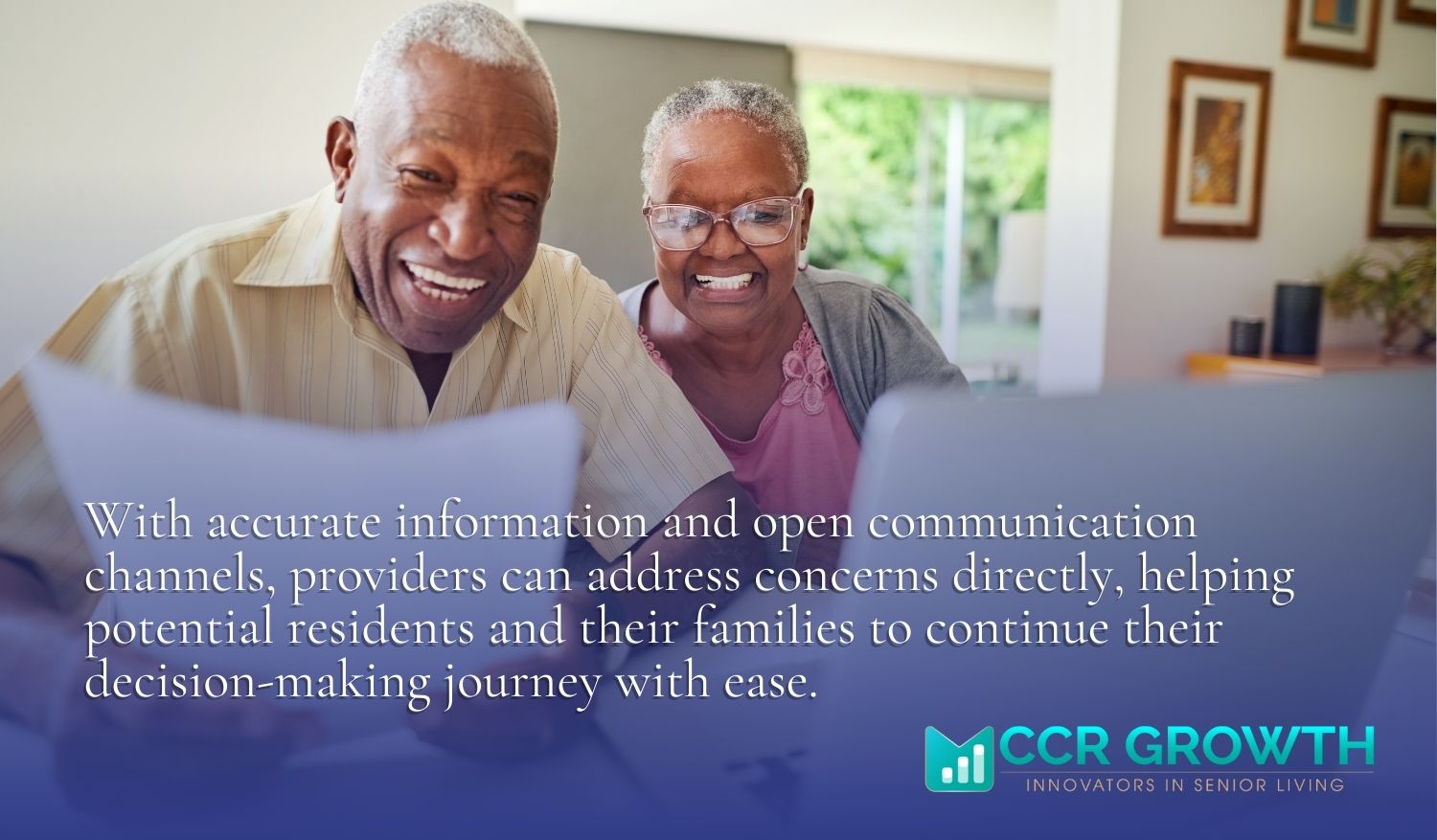
CCR Growth
How to Manage Negative Perceptions of Senior Living Effectively
There’s no disputing that negative perceptions surrounding senior living communities can pose a formidable barrier for attracting new residents to your senior living community. An analysis conducted in 2023 by The International Council on Active Aging (ICAA) and Age of Majority (AoM), discovered a discrepancy between how prospective residents perceive senior living communities versus the community’s own opinions of themselves.

According to the report, adults aged 40 and up “think of senior living environments as old, depressing, safe, and boring”. Some possible explanations might include limited exposure and a resulting fixation on stereotypes, a focus on limitations since senior living is associated with assisted living and might therefore be considered representative to some as a loss of independence, and even personal anxieties around aging.
When it comes to staff working within senior living environments, a more positive perception is more common, with over 70% saying they consider their community as “positive, fun, healthy, entertaining, and vibrant”. This stark disconnect is key to overcoming negative perceptions of senior living, starting with strategic direct marketing efforts.
5 Common Concerns about Senior Living

Every sales executive encounters objections. Here, we tackle the five common concerns prospective residents (and their families) raise, equipping you to confidently navigate these conversations and turn them into positive interactions.
Fear of Loss of Independence and Autonomy
Many people make the assumption that senior living residents have to surrender control of their daily routine, decision-making process, lifestyle choices and overall autonomy. According to the AARP report, 70% of adults over 40 want to remain independent as they age while 80% of them say they would consider moving if living arrangements enabled them to maintain this goal.
Resolving this concern involves emphasizing the amenities and customizable care options provided at modern senior living communities that enhance independence while giving residents control while receiving necessary assistance.
Lack of Social Interaction
Another widespread concern among prospective residents and their family members is social isolation, leading them to believe moving in will result in loneliness or the inability to forge meaningful friendships and form meaningful connections.
To combat this misperception and convince individuals they’ll become part of an inclusive, supportive, and socially engaging community, it’s important to find ways to showcase the vibrant social environments and engaging activities – including opportunities for friendship formation, group outings, and engaging recreational pursuits for residents residing there.
Cost Concerns
Many prospective residents and their families consider senior living to be financially prohibitive, which may prompt prospective residents to explore alternative solutions or delay making a commitment.
To overcome this perception, it’s crucial to provide transparent information about pricing structures, payment options, and potential financial assistance programs available to residents. Additionally, highlighting the value and comprehensive services included in senior living packages can help potential residents understand the long-term benefits and cost-effectiveness of choosing senior living.
Concerns About the Quality of Care
Residents and their families frequently express doubt about the quality of care provided at senior living communities, with perceptions likely stemming from prior experiences, media portrayals or misperceptions about senior living as a whole.
To address such worries effectively, providers must prioritize transparency, accountability, and continuous improvement of care standards. Sharing testimonials, accreditation details, and staff qualifications can instill trust that quality standards will always meet resident needs effectively. Ongoing communication mechanisms ensure their needs remain consistently met and exceeded.
Stereotypes About Aging Facilities
Prejudice against elderly facilities and amenities may create hesitation about senior living among older adults and their families, leading them to have reservations about joining. Perceptions about senior living communities as institutional environments could prevent them from exploring all available options for themselves.
While senior living providers should be actively implementing measures designed to counter negative perceptions, such as modernizing facilities and creating appealing living spaces, these efforts alone may not be enough. Strategic communication is the key to effectively dispelling negative stereotypes and educating older adults and their families about the true nature of senior living communities.
Negative Perceptions Impact Senior Living
It’s crucial that sales teams take time to understand how negative perceptions surrounding senior living impact transitioning older adults. This understanding will help execs to work empathetically to educate and overcome any hesitation or barriers they might be encountering. Such perceptions can evoke powerful emotional and psychological reactions, including fears of loss, social exclusion, financial strain and doubts regarding quality care delivery.
There’s no doubt that anxieties about senior living options may interfere with decision-making processes and cause individuals and their families to postpone or forgo exploring these solutions altogether. Recognizing and acknowledging these fears and uncertainties creates the basis for an approach which more effectively dispels misperceptions, builds trust, and fosters an environment which empowers older adults and their families to make well-informed and secure decisions about living arrangements.
Smart Long-Term Strategies

The following strategies not only counteract misconceptions but also enhance the overall perception of senior living as a thriving, supportive option for later life.
Start With Education and Information
Education and transparency must come first when it comes to dispelling common misperceptions surrounding senior living communities. Although most potential residents and their families understand some aspects of what options exist within senior living communities, more details regarding each aspect could be helpful in giving a full picture. From housing options available through levels of care provided, facilities offered, activities available as well as social options; going into detail will give prospective members of your community a deeper insight.
By providing accurate information and open communication channels, providers can directly address concerns. Educational blog posts and videos serve as powerful ways to dispel myths surrounding senior living options while open communication channels include an active social media community team which responds quickly when queries come in, an exhaustive FAQ list on your search engine business profile or website, Contact Us email addresses actively managed internally as well as even AI chatbots on websites.
Customized Communication
Tailored marketing approaches resonate deeply with prospective residents and their families. Customization recognizes individual needs and preferences while building trust through personal stories shared by senior living providers.
Senior living providers also can humanize the experience through storytelling by telling success stories that build confidence while dispelling any doubts that might remain about what life may hold ahead. It’s vitally important that both words and visuals be used when conveying your message: an image speaks a thousand words. Including pictures/videos showing residents living active lives within your community is an effective way of conveying your message.
Community Engagement and Social Proof
By encouraging prospects to actively engage with communities – through tours or resident testimonials for instance – helps to build up credibility and trustworthiness. Positive interactions help put prospective residents’ worries to rest about quality options available to them in our senior living facilities.
Providers should take the pulse of their own community through regular resident surveys and other forms of feedback to learn how services and facilities are truly performing. Feedback serves as a good way to ensure you can improve your offering, while positive feedback can be used in marketing efforts to highlight authentic experiences by existing residents. Leveraging social proof, such as glowing reviews, will strengthen your prospects’ confidence in the decision-making process.
Innovation and Modernization
Innovation plays an instrumental role in changing public perception. Modernization efforts such as installing safety and convenience technologies address common complaints while providing forward-looking solutions. By featuring cutting edge senior living communities, providers demonstrate their dedication to meeting changing needs and expectations.
Building Trust and Long-Term Relationships
Senior living providers understand that developing long-term relationships are integral parts of providing care for residents in senior living facilities. Through consistent communication, support, and follow-up actions they demonstrate their dedication to residents’ welfare; by prioritizing trust and engagement they foster an atmosphere where residents feel respected while making educated decisions that benefit both themselves and society at large.
Wrap-Up
Diminishing negative perceptions takes an approach built around education, transparency, and innovation. By effectively understanding and responding to such perceptions, senior living providers can attract residents while improving their reputation and overall success in the industry.
Subscribe to our newsletter
Sharpen your expertise and stay ahead of senior living industry trends—subscribe to CCR Growth’s newsletter for exclusive insights and updates.
Recent Posts



8 Top Strategies for Predictable Senior Living Growth in 2026
Redefining Senior Living Marketing, Sales, and Operations
CONTACT ADDRESS
8710 Carmel Valley Road, Carmel, CA 93923
GENERAL INQUIRIES
info@ccrgrowth.com
(831) 273-3628
SOCIAL MEDIA




